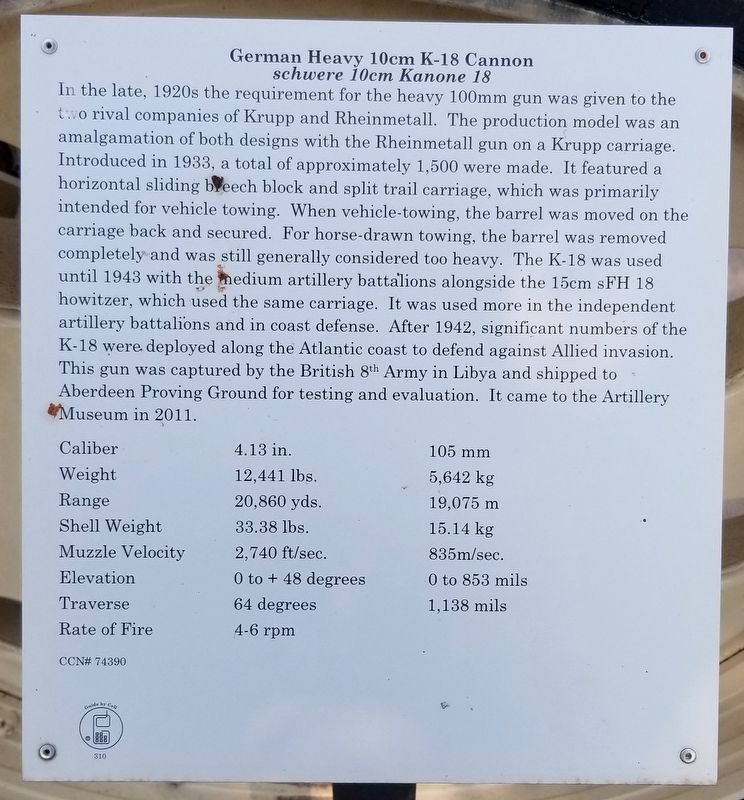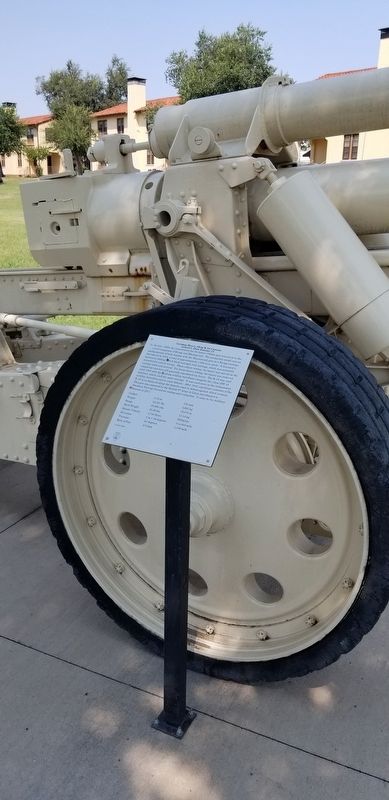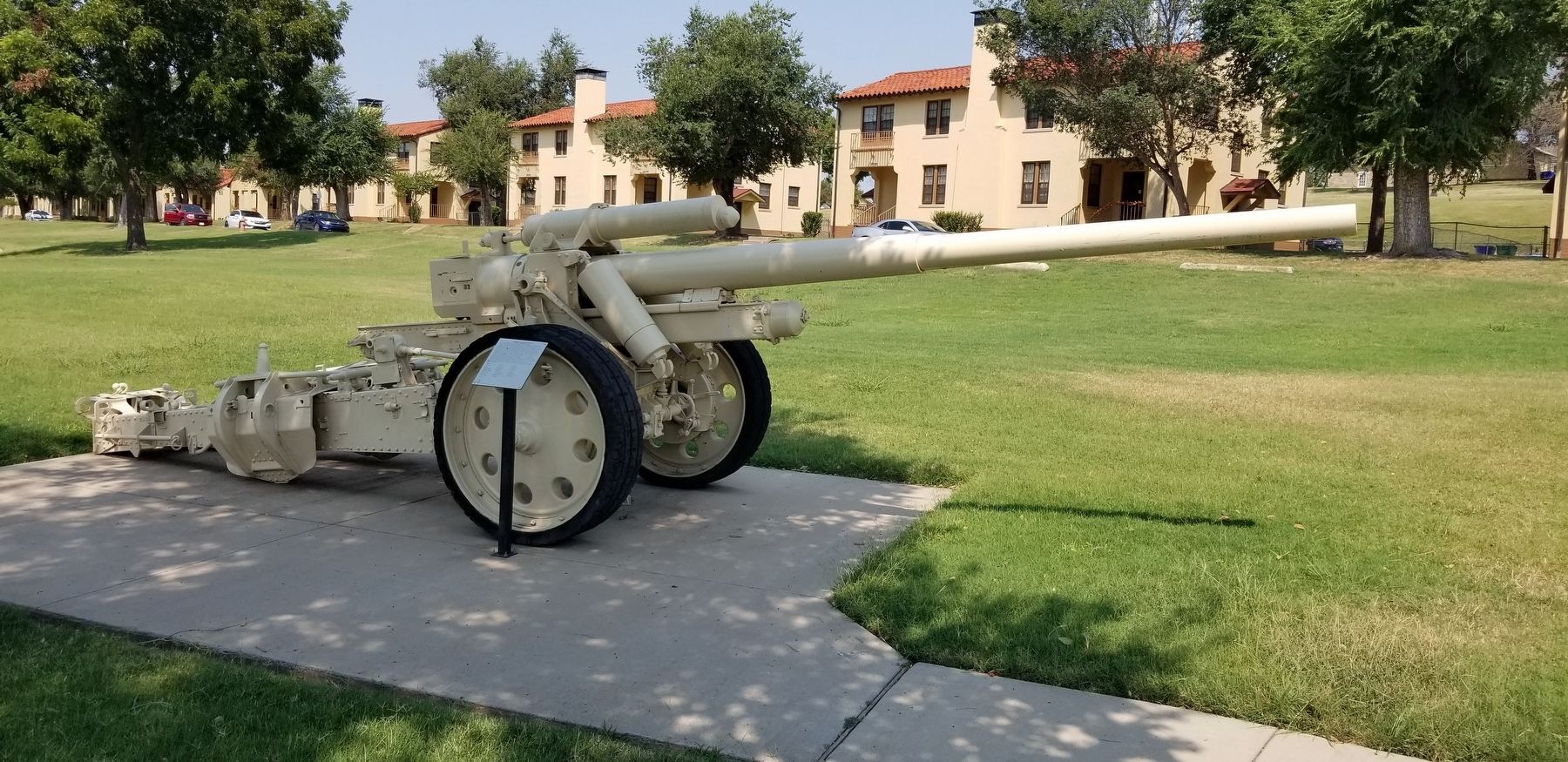Fort Sill in Comanche County, Oklahoma — The American South (West South Central)
German Heavy 10cm K-18 Cannon
schwere 10cm Kanone 18
In the late, 1920s the requirement for the heavy 100mm gun was given to the two rival companies of Krupp and Rheinmetall. The production model was an amalgamation of both designs with the Rheinmetall gun on a Krupp carriage. Introduced in 1933, a total of approximately 1,500 were made. It featured a horizontal sliding breech block and split trail carriage, which was primarily intended for vehicle towing. When vehicle-towing, the barrel was moved on the carriage back and secured. For horse-drawn towing, the barrel was removed completely and was still generally considered too heavy. The K-18 was used until 1943 with the medium artillery battalions alongside the 15cm sFH 18 howitzer, which used the same carriage. It was used more in the independent artillery battalions and in coast defense. After 1942, significant numbers of the K-18 were deployed along the Atlantic coast to defend against Allied invasion. This gun was captured by the British 8th Army in Libya and shipped to Aberdeen Proving Ground for testing and evaluation. It came to the Artillery Museum in 2011.
Caliber - 4.13 in. - 105 mm
Weight - 12,441 lbs. - 5,642 kg
Range - 20,860 yds. - 19,075 m
Shell Weight - 33.38 lbs. - 15.14 kg
Muzzle Velocity - 2,740 ft/sec. - 835m/sec.
Elevation - (0 to +48 degrees) - (0 to 853 mils)
Traverse - 64 degrees - 1,138 mils
Rate of Fire - 4-6 rpm
CCN# 74390
Erected by U.S. Army Field Artillery Museum. (Marker Number 310.)
Topics. This historical marker is listed in this topic list: War, World II. A significant historical year for this entry is 1933.
Location. 34° 40.009′ N, 98° 23.107′ W. Marker is in Fort Sill, Oklahoma, in Comanche County. Marker is at the intersection of Corral Road and Randolph Road, on the right when traveling west on Corral Road. The marker is located in the eastern section of Artillery Park at the U.S. Army Field Artillery Museum. Touch for map. Marker is in this post office area: Fort Sill OK 73503, United States of America. Touch for directions.
Other nearby markers. At least 8 other markers are within walking distance of this marker. U.S. M1 4.5-inch Gun (a few steps from this marker); U.S. M43 8-inch Howitzer Motor Carriage (a few steps from this marker); U.S. 8-Inch Howitzer, M1/M115 (within shouting distance of this marker); U.S. M1 8-Inch Gun (within shouting distance of this marker); German 88mm Anti-Aircraft 36 Gun (within shouting distance of this marker); German 150mm Heavy Howitzer (within shouting distance of this marker); French GPF 155mm Gun, Model of 1917 (within shouting distance of this marker); German 210mm Howitzer 18 (within shouting distance of this marker). Touch for a list and map of all markers in Fort Sill.
More about this marker. Marker and Museum are located on Fort Sill, an active U.S. military installation. The museum is open to the public, but appropriate identification is required for access for Fort Sill.
Also see . . . U.S. Army Field Artillery Museum. Museum website homepage (Submitted on March 13, 2022, by James Hulse of Medina, Texas.)
Credits. This page was last revised on March 14, 2022. It was originally submitted on March 13, 2022, by James Hulse of Medina, Texas. This page has been viewed 148 times since then and 20 times this year. Photos: 1, 2, 3. submitted on March 13, 2022, by James Hulse of Medina, Texas.


